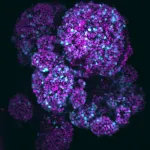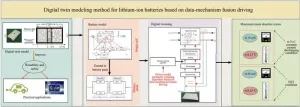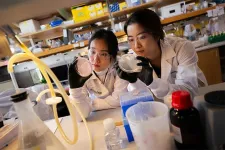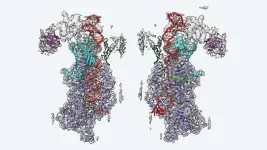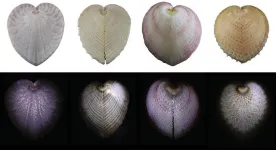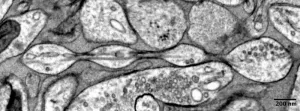(Press-News.org) Researchers from the Organoid group (previously Clevers group) at the Hubrecht Institute have developed a new organoid that mimics the human fetal pancreas, offering a clearer view of its early development. The researchers were able to recreate a complete structure that includes the three key cell types in the pancreas, which previous organoids couldn’t fully mimic. Notably, the team identified a new stem cell that develops into the three cell types. These findings, published in Cell on December 2nd, could help researchers better understand the pancreas and develop new treatments for pancreatic diseases in the future.
The pancreas has two main jobs: to help digest food and to manage blood sugar levels. For each of these tasks, the organ uses different types of cells. Scientist can study how the pancreas works by looking at organoids — tiny organs, about 1 mm in size that are grown in the lab. However, most organoids up until now could only exist of one type of cell at a time. This makes it harder for scientists to understand the pancreas as a whole. “We wanted to create an organoid that includes all the cell types found in a real pancreas”, explains Amanda Andersson Rolf, first author of the study. “With such an organoid, we could study how these different cells interact and gain a deeper understanding of how the pancreas develops.”
Creating a complete organoid
Andersson Rolf and her fellow researchers used tissue from the pancreas to create a new three-dimensional organoid that imitates the human pancreas in its fetal stage. This organoid contained the three main types of pancreas cells: acinar cells, ductal cells, and endocrine cells. Each of these cells plays a vital role. Acinar cells release enzymes that help break down food, while ductal cells form channels to carry the enzymes to the gut. Finally, endocrine cells produce hormones like insulin to control sugar levels in the blood.
“In our organoid, we discovered and characterized a new type of stem cell that has the unique ability to develop into all three cell types”, Andersson Rolf continues. “We saw that the three cell types not only formed but also performed their expected functions. The acinar cells released digestive enzymes and the endocrine cells produced hormones.”
Pancreas organoid gives new clues
Using these organoids, the researchers discovered new information about how the pancreas develops. “The stem cell of the fetal pancreas is present longer than scientists have seen in earlier studies with mice”, Andersson Rolf says. Interestingly, the organoids grown from one of these stem cells can grow rapidly over several years while still being able to produce the three main cell types of the pancreas. Andersson Rolf and her colleagues also found another crucial difference between mouse and human pancreatic development. “We saw the presence of a protein called LGR5, which marks stem cells across different tissues. This protein appears in human pancreatic stem cells but not in mice”, Andersson Rolf explains. “Our research highlights the importance of studying human biology, as we couldn’t have discovered this using animal cells”, she notes.
Future perspective
The new organoid that mimics the fetal pancreas can give scientists new ways to study how genes and the environment affect the development and health of the pancreas. Ultimately, studying these organoids could help develop regenerative therapies and new drugs to treat pancreatic diseases. “However, we first need to fully understand how the cells and molecules in the human pancreas work together during development and in disease”, Andersson Rolf explains. “We are just starting to scratch the surface.”
Publication
Long-term in vitro expansion of a human fetal pancreas stem cell that generates all three pancreatic cell lineages. Amanda Andersson-Rolf, Kelvin Groot, Jeroen Korving, Harry Begthel, Maaike A.J. Hanegraaf, Michael VanInsberghe, Fredrik Salmén, Stieneke van den Brink, Carmen Lopez-Iglesias, Peter J. Peters, Daniel Kruger, Joep Beumer, Maarten H. Geurts, Anna Alemany, Helmuth Gehart, Françoise Carlotti, Eelco J.P. de Koning, Susana M. Chuva de Sousa Lopes, Alexander van Oudenaarden, Johan van Es, Hans Clevers. Cell 2024.
About the Hubrecht Institute
Research at the Hubrecht Institute is pioneering in developmental and stem cell biology. The institute encompasses 20 research groups that perform fundamental, multidisciplinary research on healthy and diseased cells, tissues and organisms.The Hubrecht Institute is a research institute of the Royal Netherlands Academy of Arts and Sciences (KNAW), situated on the Utrecht Science Park. Since 2008, the Hubrecht is affiliated with the UMC Utrecht. This allowed the institute to grow into an internationally renowned research institute and facilitated the link with (pre)clinical research. The Hubrecht Institute has a partnership with the European Molecular Biology Laboratory (EMBL) based on shared institutional goals, scientific synergy and complementarity.
About Hans Clevers
Hans Clevers is advisor/guest researcher at the Hubrecht Institute for Developmental Biology and Stem Cell Research (KNAW) and at the Princess Máxima Center for Pediatric Oncology. He holds a professorship in Molecular Genetics from the Utrecht University and is Investigator at Oncode Institute. Hans Clevers has been the Head of Pharma Research and Early Development (pRED) at Roche since 2022. He previously held directorship/President positions at the Hubrecht Institute, the Royal Netherlands Academy of Arts and Sciences and the Princess Máxima Center for pediatric oncology.
END
Researchers create a new organoid with all key pancreas cells
2024-12-02
ELSE PRESS RELEASES FROM THIS DATE:
Stimulating hypothalamus restores walking in paralyzed patients
2024-12-02
Researchers at EPFL and Lausanne University Hospital (CHUV), led by professors Grégoire Courtine and Jocelyne Bloch, have achieved a major milestone in the treatment of spinal cord injuries (SCI). By applying deep brain stimulation (DBS) to an unexpected region in the brain—the lateral hypothalamus (LH)—the team has improved the recovery of lower limb movements in two individuals with partial SCI, greatly improving their autonomy and well-being.
Wolfgang Jäger, a 54-year-old from Kappel, Austria, has been in a wheelchair ...
Pioneering digital twin model elevates lithium-ion battery performance and safety
2024-12-02
Source: Beijing Institute of Technology Press
Lithium-ion batteries are celebrated for their high specific energy, long service life, and low self-discharge rates. However, ensuring their reliability and safety under various operating conditions is critical for their continued success in industrial applications. Digital twin technology, which creates a virtual replica of a physical entity, offers a promising solution by enabling real-time monitoring and optimization of battery performance. This technology facilitates interactive feedback, data fusion, and iterative ...
A breakthrough in battery capacity degradation analysis and knee point prediction
2024-12-02
Analyzing capacity degradation characteristics and accurately predicting the knee point of capacity are crucial for the safety management of lithium-ion batteries (LIBs). A recent breakthrough study presented by researchers from Shandong University introduces a knee point prediction method based on neural network. This advanced method can help us clarify the degradation mechanism and predict the knee point.
The study focuses on battery life, which is the result of multiple coupling aging mechanisms affected by multiple factors. It is significantly necessary to clarify the mechanism for the capacity degradation at each stage and possess the ability to detect the knee point. It can not only ...
Newfound mechanism may explain why some cancer treatments boost risk of heart disease
2024-12-02
A cancer therapy that prompts the body’s immune defenses against viruses and bacteria to attack tumors can make patients more vulnerable to heart attack and stroke. A possible explanation for this side effect is that the treatment interferes with immune regulation in the heart’s largest blood vessels, a new study suggests.
Led by researchers at NYU Langone Health and its Perlmutter Cancer Center, the new work focused on a potent class of cancer-fighting drugs called immune checkpoint inhibitors. These medications ...
Research alert: How artificial intelligence could automate genomics research
2024-12-02
Researchers at University of California San Diego School of Medicine have demonstrated that large language models (LLMs), such as GPT-4, could help automate functional genomics research, which seeks to determine what genes do and how they interact. The most frequently-used approach in functional genomics, called gene set enrichment, aims to determine the function of experimentally-identified gene sets by comparing them to existing genomics databases. However, more interesting and novel biology is often beyond the scope of established databases. Using artificial intelligence (AI) to analyze gene ...
‘I don’t feel your pain’: How alcohol increases aggression
2024-12-02
COLUMBUS, Ohio – Alcohol’s ability to increase people’s pain threshold is one reason that drinking also leads to more aggressive behavior, a new study suggests.
Researchers found that the less pain that study participants felt after drinking an alcoholic beverage, the more pain they were willing to inflict on someone else.
“We’ve all heard the idiom ‘I feel your pain,’” said study co-author Brad Bushman, professor of communication at The Ohio State University.
“But if intoxicated people can’t feel their own pain, they might be less likely to feel ...
The Microprocessor inside you
2024-12-02
It’s a big year for microRNAs. The 2024 Nobel Prize in Physiology or Medicine went to Victor Ambros and Gary Ruvkun, who discovered the first microRNA in 1993. Today, we know that humans make more than 1,000 different microRNAS. These molecules are critical for building and maintaining healthy bodies, so it’s crucial that they’re made the right way. Errors in microRNA manufacture can put us at risk for developmental disorders, cancer, or neurodegenerative disease.
To learn how cells accurately generate a mind-boggling array of microRNAs, Cold Spring Harbor Laboratory (CSHL) Professor and HHMI Investigator Leemor ...
Landmark World Drought Atlas reveals systemic nature of hazard risks, underlines need for national plans, international cooperation
2024-12-02
Riyadh, Saudi Arabia — As record-breaking droughts are becoming a new normal around the globe, the UN Convention to Combat Desertification (UNCCD) and the European Commission Joint Research Centre (JRC) launch the most comprehensive global publication on drought risks and solutions as an urgent wake-up call for world leaders and citizens.
The landmark new World Drought Atlas depicts the systemic nature of drought risks through dozens of maps, infographics, and case studies. It illustrates how drought risks are interconnected across sectors like energy, agriculture, river transport, and international trade and how they can trigger cascading effects, fueling inequalities and ...
To build better fiber optic cables, ask a clam
2024-12-02
DURHAM, N.C. -- Since the first fiber optic cables rolled out in the 1970s, they’ve become a major part of everything from medical devices to high-speed internet and cable TV. But as it turns out, one group of marine mollusks was way ahead of us.
A new study reveals that clams called heart cockles -– so-named because of their heart-shaped shells -- have unique structures in their shells that act like fiber optic cables to convey specific wavelengths of light into the bivalves’ tissues.
Researchers from Duke University and Stanford University used electron and laser microscopy and computer simulations ...
Study may reverse century-old understanding of the shape of ‘arms’ on mammals’ brain cells
2024-12-02
**EMBARGOED FOR RELEASE UNTIL MONDAY, DEC. 2, AT 5 A.M.**
Biology textbooks may need a revision, say Johns Hopkins Medicine scientists, who present new evidence that an armlike structure of mammalian brain cells may be a different shape than scientists have assumed for more than a century.
Their study on mouse brain cells shows that the cells’ axons — the armlike structures that reach out and exchange information with other brain cells — are not the cylindrical tubes often pictured in books and on websites ...
